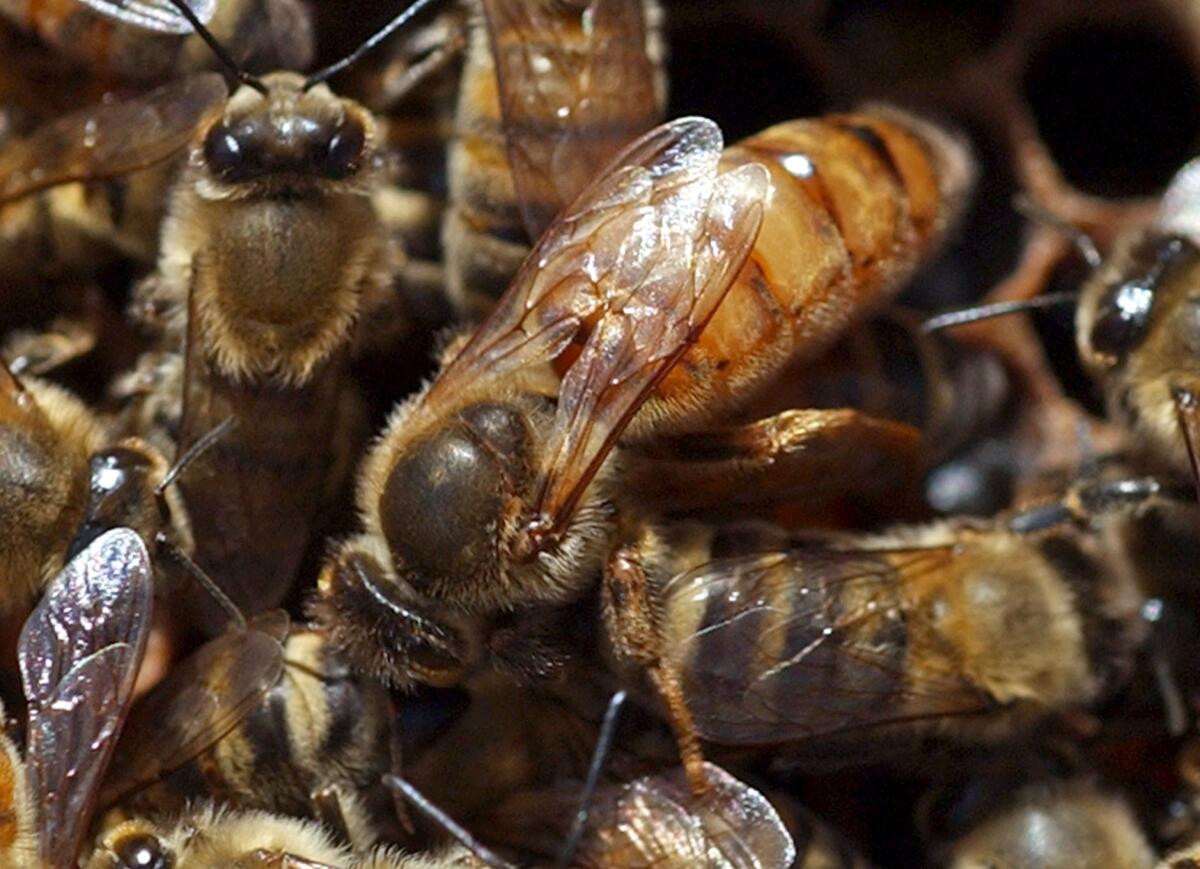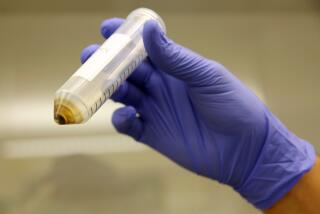Bees threatened by a common pesticide, EPA finds

A queen bee is seen in the center of a hive.
An insecticide widely used on grains, vegetables, fruit and other crops nationwide threatens honeybees, federal environmental regulators said in a decision that could lend impetus to efforts to ban the chemical.
The U.S. Environmental Protection Agency said Wednesday that imidacloprid, a nicotine-imitating chemical found in at least 188 farm and household products in California, “potentially poses risk to hives when the pesticide comes in contact with certain crops that attract pollinators.”
The EPA’s decision was prompted by increasing concern that the chemicals might be contributing to the sudden collapse of commercial honey bee colonies over the last decade.
Those bees pollinate crucial food crops and contribute about $14 billion in value to the agricultural economy nationwide.
This is the first of four risk assessments conducted by the EPA on the class of pesticides known as neonicotinoids. The rest are slated for completion by the end of the year, after which the agency could tighten controls over the insecticides.
California already prohibits use of the chemical on almonds and limits its application for other crops during bloom periods when bees are most likely to be present.
“Clearly, as a result of this, there might be more restrictions coming,” said Charlotte Fadipe, spokeswoman for the California Department of Pesticide Regulation.
------------
FOR THE RECORD: In the Jan. 7 Business section, an article about pesticide threats to bees said that oranges and grapefruit were among the crops dependent on commercial bee colonies for pollination. Those crops are self-pollinating and do not require commercial bee colonies.
------------
California’s almond crop, valued at about $7 billion, is completely dependent on nearly 1 million commercial hives brought in to pollinate about 870,000 acres of trees. Other crops that depend strongly on commercial honeybee colonies include oranges and grapefruits, blueberries, cherries, alfalfa, apples, avocados, cucumbers, onions, cantaloupe, cranberries, pumpkins and sunflowers.
California farmers applied nearly 144 tons of the chemical, originally manufactured by Bayer CropScience, on more than 1.5 million acres in 2013, the last year for which complete data were available, according to the state Department of Pesticide Regulation. The top users were wine grape growers, which applied 30 tons of it to about 240,000 acres in 2013, according to the state agency. Growers of table and raisin grapes, tomatoes for processing, oranges and cotton also were among the heaviest agricultural users, according to the agency.
The single biggest user, however, was the predominantly urban structural pest control industry, which applied nearly 37 tons, according to the agency.
Several studies have linked high levels of neonicotinoids to decreased foraging, failures of queen bees, breakdowns in hive communication and other colony-threatening phenomena. Last year, however, a study suggested that exposure to levels of the pesticide expected on most farms would pose no significant negative effects on bee colonies.
Many factors have been blamed for the bee die-offs: exposure to multiple pesticides, poor hive management practices and natural pathogens such as mites and viruses. Although full-scale colony collapses have largely abated over the last several years, bees are continuing to die at a higher-than-normal rate. The USDA last year reported winter colony losses of about 23%, based on a survey of beekeepers. A winter decline of about 19% is considered normal.
The EPA and its research partners weighed evidence from several hundred scientific studies before concluding that chemical traces of more than 25 parts per billion on plants probably will harm bees.
Last year, the agency halted approval of any new outdoor uses of neonicotinoid pesticides until it completes a full risk assessment. It also has proposed banning use of any pesticide found to be toxic to bees while crops are in bloom and commercial colonies are present.
Bayer CropScience said the EPA’s assessment “appears to overestimate the potential for harmful exposures in certain crops, such as citrus and cotton, while ignoring the important benefits these products provide and management practices to protect bees.”
The company added that it hoped the agency further considers “the best available science, as well as a proper understanding of modern pest management practices.”
Pesticide industry advocates said it was premature to talk about a ban on the chemical.
“I think there’s a lot more work to be done, but we’re pretty confident that the product is ultimately going to be found safe either as registered or with potentially any mitigation measures that need to be added,” said Renee Pinel, president of the Western Plant Health Assn. in Sacramento.
The Center for Biological Diversity, an environmental advocacy group, chided EPA for not broadening its investigation beyond the honey bee, to the more than 4,000 wild bee species, and to other pollinators, including butterflies and bats.
“You can’t claim to do a ‘pollinator risk assessment’ and really only look at one pollinator, the honeybee,” said Lori Ann Burd, environmental health director of the group. “That’s not only cheating on the purpose of this work but also cheating the native bees, birds, butterflies and other species threatened by this pesticide.”
Two other groups, the Center for Food Safety and the Pesticide Action Network, filed a lawsuit Wednesday against EPA, seeking tighter regulation of seeds coated in neonicotinoids.
Jeff Anderson, a Minnesota beekeeper and plaintiff in the suit, said EPA “didn’t say anything of substance” and did not commit to changing any regulations on neonicotinoids.
Anderson rents hives to California almond growers, then to growers of cherries, apples and blueberries, before bringing them back to Minnesota for honey production in the late spring and summer. There, he has lost as much as 50% of his 3,000 bees, at a time when coated seeds are planted and cultivated.
Dust from the seeds can spread the pesticide, which also is taken up into the plant, and can be detected in its nectar and pollen, said Scott Black, executive director of the Xerces Society, which pushes for conservation of insects.
“You really can’t look at total risk to pollinators without looking at seed coating, and you really can’t look at total risk to pollinators without looking at the 4,000 or so other species,” Black said.
geoffrey.mohan@latimes.com
Twitter: @LATgeoffmohan







